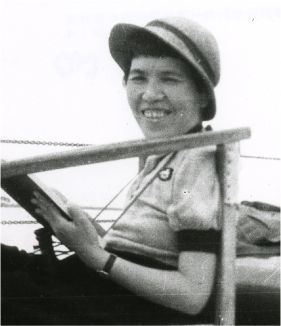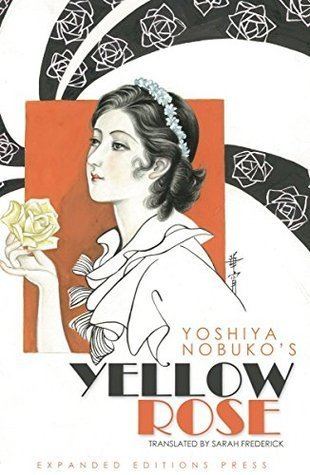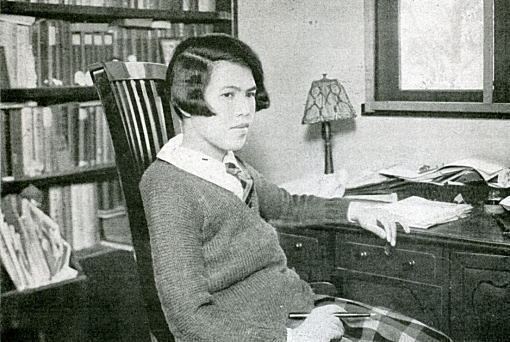Occupation Novelist Name Nobuko Yoshiya | Role Novelist | |
 | ||
Born 12 January 1896Niigata, Japan ( 1896-01-12 ) Died July 11, 1973, Kamakura, Kanagawa Prefecture, Japan | ||
Yuricast #17 - Nobuko Yoshiya
Nobuko Yoshiya (吉屋信子, Yoshiya Nobuko, 12 January 1896 – 11 July 1973) was a Japanese novelist active in Taishō and Showa period Japan. She was one of modern Japan's most commercially successful and prolific writers, specializing in serialized romance novels and adolescent girls' fiction, as well as a pioneer in Japanese lesbian literature, including the Class S genre. Several of her stories have been made into films.
Contents
- Yuricast 17 Nobuko Yoshiya
- Personal life
- Relationship with Monma Chiyo
- Literary career
- Literary style
- Political views
- References

Personal life

Yoshiya was born in Niigata prefecture, but grew up in Mooka and Tochigi cities in Tochigi prefecture. Her father was first a police officer and then became a local county government official, so her family relocated often to accommodate his transfers. She was the only daughter and youngest of five children in her family. Both her mother and her father came from samurai families. Her middle-class, culturally conservative parents trained her for the "good wife, wise mother" role expected of women in Meiji Japan. Her literary career began when she was in her teens, although prior to this she had developed a love for writing which sapped her time for learning domestic skills from her mother.

In 1915 she moved to Tokyo, where she began to diverge from Japan's career and gender expectations. Yoshiya often dressed in an androgynous style, including in magazine photo sessions. She was one of the first Japanese women to emulate Western fashion in the 1920s by cutting her hair short. Yoshiya defied expectations in other ways. She was one of the first Japanese women to own a car, she designed her own house, and was the first Japanese women to own a racehorse, which (along with golf) would become a passion of hers.

Yoshiya lived in Kamakura, Kanagawa prefecture during and after World War II. In 1962 she built a traditional wooden house with Japanese-style garden in a quiet setting, which she willed to the city of Kamakura on her death, to be used to promote women's cultural and educational activities. She died at age 77 of colon cancer. Her house is now the Yoshiya Nobuko Memorial Museum, and preserves the study as she left it, with items such as handwritten manuscripts and favorite objects are on display. However, the museum is open only twice a year, in early May and November, for three days each time. Her grave is at the temple of Kōtoku-in in Kamakura, behind the famous Kamakura Daibutsu.
Relationship with Monma Chiyo
On January 1923, Yoshiya met Monma Chiyo, a mathematics teacher at girls' school in Tokyo. They would go on to have a same-sex relationship for over 50 years. Unlike many Japanese public persona, she was not reticent about revealing details of her personal life through photographs, personal essays and magazine interviews. In 1926, they established a collaborative working relationship of author and secretary. In 1957, Yoshiya adopted Monma as her daughter, the only legal way for lesbians to share property and make medical decisions for each other. They both traveled together to Manchuria, the Soviet Union, stayed for a year in Paris and then returned via the United States to Japan from 1927-1928. In the late 1930s, they also visited the Netherlands East Indies and French Indochina.
Literary career
One of her early works, Hana monogatari ( 花物語 "Flower Tales", 1916–1924), a series of fifty-two tales of romantic friendships, became popular among female students. Most of the relationships presented in Flower Tales are those of longing from afar, unrequited love, or an unhappy ending. These stories often depict female-female desire in an almost narcissistic way by employing a dreamy writing style.
Yaneura no nishojo ( 屋根裏の二處女 "Two Virgins in the Attic", 1919) is thought to be semi-autobiographical, and describes a female-female love experience with her dormmate. In the last scene, the two girls decide to live together as a couple. This work, in attacking male-oriented society, and showing two women as a couple after they have finished secondary education presents a strong feminist attitude, and also reveals Yoshiya's own lesbian sexual orientation.
Her Chi no hate made ("To the Ends of the Earth", 1920), won a literary prize by the Osaka Asahi Shimbun, and reflects some Christian influence.
In 1925, Yoshiya began her own magazine, Kuroshoubi (Black Rose), which she discontinued after eight months. After Black Rose, Yoshiya began presenting adult same-sex love as being akin to 'sisterhood' and complementary to heterosexuality, becoming more mainstream in her works.
Yoshiya's other major works include Onna no yujo ("Women's Friendship", 1933–1934), Otto no Teiso ( 良人の貞操 "A Husband's Chastity", 1936–1937), Onibi (鬼火 "Demon Fire", 1951), Atakake no hitobito ( 安宅家の人々 "The Ataka Family", 1964–1965), Tokugawa no fujintachi ( 徳川の夫人たち "Tokugawa Women", 1966) and Nyonin Heike ( 女人平家 "Ladies of the Heike", 1971)
Literary style
Yoshiya explored two main themes throughout her work: friendship between women and the idea of the "ideal" male. Her works are keenly aware of contemporary sexology.
Although not all of Yoshiya's works depict same-sex romance between girls, even in plots with heterosexual domestic melodrama, her novels tended to avoid depictions of marriage. Her writing style was marked by onomatopoeia, exclamation points and other unusual diacritical marks, which were considered aesthetically appealing by her female readers, and were part of a movement to introduce realistic dialogue into stories. Her use of imagery, especially in setting scenes in unexpected locations, such as an attic or veranda, aided in creating a melodramatic atmosphere.
Yoshiya's stories were considered "respectable" texts, suitable for consumption by girls and women of all ages, as the lesbian attachments are depicted as emotionally intense yet platonic relationships, destined to be curtailed by graduation from school, marriage, and/or death. This can be explained in part by the contemporary understanding that same-sex love was a transitory and "normal" part of female development leading into heterosexuality and motherhood.
Her stories of dosei-ai (same-sex love) and of female friendships had a direct influence on later Shōjo manga. In particular, her works often fall in line with the Class S genre, which depict lesbian attachments as emotionally intense yet platonic relationships, destined to be curtailed by marriage, school, or death.
Political views
Though an ardent feminist, Yoshiya mistrusted political parties and never became active in the organized Japanese feminist movement.
